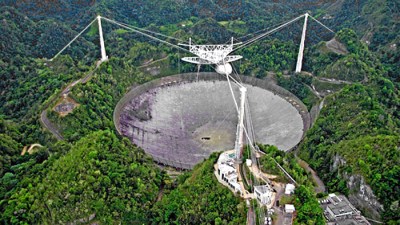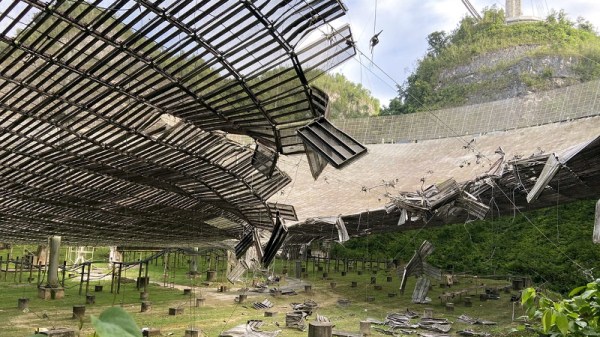In the relatively short time that the James Webb Space Telescope has been operational, there’s seemingly no end to its list of accomplishments. And if you’re like us, you were sure that Webb had already achieved the first direct imaging of a planet orbiting a star other than our own a long time ago. But as it turns out, Webb has only recently knocked that item off its bucket list, with the direct visualization of a Saturn-like planet orbiting a nearby star known somewhat antiseptically as TWA 7, about 111 light-years away in the constellation Antlia. The star has a significant disk of debris orbiting around it, and using the coronagraph on Webb’s MIRI instrument, astronomers were able to blot out the glare of the star and collect data from just the dust. This revealed a faint infrared source near the star that appeared to be clearing a path through the dust.
planetary defense4 Articles
NASA Taps Webb To Help Study 2032 Asteroid Threat
In all likelihood, asteroid 2024 YR4 will slip silently past the Earth. Based on the data we have so far, there’s an estimated chance of only 2.1% to 2.3% that it will collide with the planet on December 22nd, 2032. Under normal circumstances, if somebody told you there was a roughly 98% chance of something not happening, you probably wouldn’t give it a second thought. There’s certainly a case to be made that you should feel that way in regards to this particular event — frankly, it’s a lot more likely that some other terrible thing is going to happen to you in the next eight years than it is an asteroid is going to ruin your Christmas party.
That being said, when you consider the scale of the cosmos, a 2+% chance of getting hit is enough to raise some eyebrows. After all, it’s the highest likelihood of an asteroid impact that we’re currently aware of. It’s also troubling that the number has only gone up as further observations of 2024 YR4’s orbit have been made; a few weeks ago, the impact probability was just 1%. Accordingly, NASA has recently announced they’ll be making time in the James Webb Space Telescope’s busy scientific schedule to observe the asteroid next month.
So keeping in mind that we’re still talking about an event that’s statistically unlikely to actually occur, let’s take a look at what we know about 2024 YR4, and how further study and analysis can give us a better idea of what kind of threat we’re dealing with.
Continue reading “NASA Taps Webb To Help Study 2032 Asteroid Threat”
Watch NASA Crash A Probe Into An Asteroid Tonight
Got any plans for tonight? No? Well then you’re in luck, because NASA is just a few hours from intentionally smashing a probe into the minor planet Dimorphos as part of Double Asteroid Redirection Test (DART) — marking the first time humanity has ever intentionally tried to knock a space rock off-course. If it works, we’re one step closer to having a viable planetary defense system in case we ever detect an asteroid on a collision course with Earth. If it doesn’t work. . . well, we’ve still got time to come up with another plan.
To be clear, the 170 meter (560 feet) wide Dimorphos DOES NOT pose any threat to us, nor will it after NASA smacks it around with an ion-propelled spacecraft. This is simply a test to see if a small spacecraft impacting an asteroid head-on can slow it down enough to appreciably change its orbital trajectory. We won’t know for a week or so if the impact did the trick, but it should still be fascinating to watch the crash happen live.
We’ve embedded the two NASA streams below. The first one will start about a half an hour before impact and is going to show live navigational images of Dimorphos as the DART spacecraft zeros in on its target, and the second stream will cover the main event. Keep in mind this isn’t a Hollywood film we’re talking about — don’t expect any dramatic explosions when the clock hits zero. When the telemetry stops coming back, that means it was a bullseye.
Continue reading “Watch NASA Crash A Probe Into An Asteroid Tonight”
Damage To Arecibo Leaves Gaping Hole In Astronomy
In the early morning hours of August 10th, a support cable at the Arecibo Observatory pulled lose from its mount and crashed through the face of the primary reflector below. Images taken from below the iconic 305 meter dish, made famous by films such as Contact and GoldenEye, show an incredible amount of damage. The section of thick cable, estimated to weigh in at around 6,000 kilograms (13,000 pounds), had little difficulty tearing through the reflector’s thin mesh construction.
Worse still, the cable also struck the so-called “Gregorian dome”, the structure suspended over the dish where the sensitive instruments are mounted. At the time of this writing it’s still unclear as to whether or not any of that instrumentation has been damaged, though NASA at least has said that the equipment they operate inside the dome appears to have survived unscathed. At the very least, the damage to the dome structure itself will need to be addressed before the Observatory can resume normal operations.

It’s far too early to know how much time and money it will take to get Arecibo Observatory back up to operational status, but with the current world situation, it seems likely the telescope will be out of commission for at least the rest of the year. Given the fact that repairs from the 2017 damage still haven’t been completed, perhaps even longer than that. In the meantime, astronomers around the globe are left without this wholly unique resource.
Continue reading “Damage To Arecibo Leaves Gaping Hole In Astronomy”














